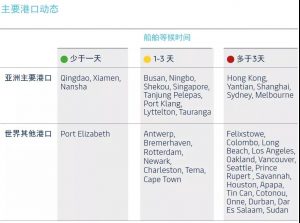This wave of growth started quietly at the end of October, and there was a big explosion at the end of November. By the beginning of December, the freight rates of almost all major ports in Southeast Asia have generally increased nearly doubled in just one month.
Take South China to Ho Chi Minh Port as an example. From the end of October to the beginning of December, the ocean freight for a 40-foot container skyrocketed from about US$500 to US$2,000 to US$2,500, a maximum increase of 5 times. At present, among the first-hand freight rates received from shipping companies, shipping prices from domestic to Southeast Asian countries have risen from US$500 to US$1,000. Compared with the previous two weeks, the rate of increase ranges from 80% to 200%. Among them, 20GP/40GP/40HQ cabinets The freight rates are respectively 1530 U.S. dollars, 3060 U.S. dollars, and 3060 U.S. dollars. Shipping costs in Southeast Asia before the epidemic were only around US$200-300.
In July and August of this year, the Southeast Asian epidemic broke out, and many shipowners diverted their capacity to popular ocean routes. However, foreign countries continue to be congested in ports, and many ships will not be able to return for a while. The original scheduled sailing schedule was disrupted, coupled with the suspension of sailings and port jumps, resulting in the possibility of changing from four sailings a month to two or even one sailing on Southeast Asian routes, and the capacity has been severely reduced. In addition, major ports in Southeast Asia have experienced varying degrees of congestion. For example, the congestion of TANJUNG PELEPAS in Malaysia is quite serious, affecting the receiving of goods in some Southeast Asian destinations. According to Maersk’s latest Asia-Pacific supply chain market trend report (November 2021), the dynamics of major global ports are as follows:

According to data from Sea Explorer, a comprehensive maritime service digital platform, as of November 29, based on port efficiency, severe weather, and the situation of the ship itself, there are currently at least 495 ships waiting to berth around the world, and many ports on all continents are facing Operations are interrupted. Existing shipping companies quickly turned the container capacity from the congested U.S. West to the Asian route. Wanhai Shipping stated that it is transferring vessels from its six Asia-Western US routes to its intra-Asia routes.
Following the launch of the Regional Comprehensive Economic Partnership Agreement (RCEP) and the unblocking of Southeast Asian countries, the market demand for the near-ocean line is strong. At present, the latest SCFI freight index of the Shanghai Air Exchange has soared to a new high, and the freight rates of the Eastern U.S., Western U.S., and Southeast Asia routes have surged across the board. Among them, the Western U.S. Line has exceeded the US$7,000 mark in one fell swoop, setting a record high. According to SCFI’s latest quotation: US$7019 per 40-foot container on the West Coast Line, a weekly increase of 4.2%, surpassed the new sky-high price; US$10,623 per 40-foot container on the East Coast of the U.S., a weekly increase of 1.8%, a two-week increase; The Southeast Asia line was US$1,266 per 20-foot container, a weekly increase of 12.6%.
In this regard, our foreign trade companies must pay attention to changes, keep paying attention to the freight, and update the quotation in real-time.